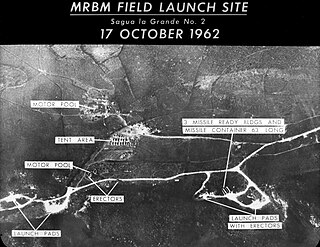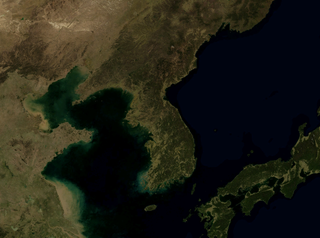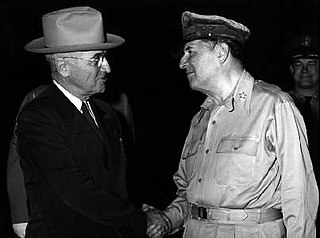
The Korean War was an armed conflict on the Korean Peninsula fought between North Korea and South Korea and their allies. North Korea was supported by the People's Republic of China and the Soviet Union, while South Korea was supported by the United Nations Command (UNC) led by the United States. The conflict was the first major proxy war of the Cold War. Fighting ended in 1953 with an armistice but no peace treaty, leading to the ongoing Korean conflict.

Nuclear warfare, also known as atomic warfare, is a military conflict or prepared political strategy that deploys nuclear weaponry. Nuclear weapons are weapons of mass destruction; in contrast to conventional warfare, nuclear warfare can produce destruction in a much shorter time and can have a long-lasting radiological result. A major nuclear exchange would likely have long-term effects, primarily from the fallout released, and could also lead to secondary effects, such as "nuclear winter", nuclear famine, and societal collapse. A global thermonuclear war with Cold War-era stockpiles, or even with the current smaller stockpiles, may lead to various scenarios including human extinction.

World War III, also known as the Third World War, is a hypothetical future global conflict subsequent to World War I (1914–1918) and World War II (1939–1945). It is widely assumed that such a war would involve all of the great powers, like its predecessors, as well as the use of nuclear weapons or other weapons of mass destruction, surpassing all prior conflicts in geographic scope, devastation and loss of life.

Brinkmanship or brinksmanship is the practice of trying to achieve an advantageous outcome by pushing dangerous events to the brink of active conflict. The maneuver of pushing a situation with the opponent to the brink succeeds by forcing the opponent to back down and make concessions rather than risk engaging in a conflict that would no longer be beneficial to either side. That might be achieved through diplomatic maneuvers, by creating the impression that one is willing to use extreme methods rather than concede. The tactic occurs in international politics, foreign policy, labor relations, contemporary military strategy, terrorism, and high-stakes litigation.

Containment was a geopolitical strategic foreign policy pursued by the United States during the Cold War to prevent the spread of communism after the end of World War II. The name was loosely related to the term cordon sanitaire, which was containment of the Soviet Union in the interwar period.
United States Objectives and Programs for National Security, better known as NSC 68, was a 66-page top secret U.S. National Security Council (NSC) policy paper drafted by the Department of State and Department of Defense and presented to President Harry S. Truman on 7 April 1950. It was one of the most important American policy statements of the Cold War. In the words of scholar Ernest R. May, NSC 68 "provided the blueprint for the militarization of the Cold War from 1950 to the collapse of the Soviet Union at the beginning of the 1990s." NSC 68 and its subsequent amplifications advocated a large expansion in the military budget of the United States, the development of a hydrogen bomb, and increased military aid to allies of the United States. It made the rollback of global Communist expansion a high priority and rejected the alternative policies of détente and containment of the Soviet Union.

Aerial supremacy is the degree to which a side in a conflict holds control of air power over opposing forces. There are levels of control of the air in aerial warfare. Control of the air is the aerial equivalent of command of the sea.

"The wrong war, at the wrong place, at the wrong time, and with the wrong enemy" is General Omar Bradley's famous rebuke in his May 15, 1951 Congressional testimony as the Chairman of the Joint Chiefs of Staff to the idea of extending the Korean War into China, as proposed by General Douglas MacArthur, the commander of the U.N. forces in Korea before being relieved of command by President Harry Truman on April 11, 1951.
The Prevention of Nuclear War Agreement was created to reduce the danger of nuclear war between the United States and the Union of Soviet Socialist Republics. The agreement was signed at the Washington Summit, on June 22, 1973. The United States and the U.S.S.R. agreed to reduce the threat of a nuclear war and establish a policy to restrain hostility.

The surrender of the Empire of Japan in World War II was announced by Emperor Hirohito on 15 August and formally signed on 2 September 1945, ending the war. By the end of July 1945, the Imperial Japanese Navy (IJN) was incapable of conducting major operations and an Allied invasion of Japan was imminent. Together with the United Kingdom and China, the United States called for the unconditional surrender of Japan in the Potsdam Declaration on 26 July 1945—the alternative being "prompt and utter destruction". While publicly stating their intent to fight on to the bitter end, Japan's leaders were privately making entreaties to the publicly neutral Soviet Union to mediate peace on terms more favorable to the Japanese. While maintaining a sufficient level of diplomatic engagement with the Japanese to give them the impression they might be willing to mediate, the Soviets were covertly preparing to attack Japanese forces in Manchuria and Korea in fulfillment of promises they had secretly made to the US and the UK at the Tehran and Yalta Conferences.

The New Look was the name given to the national security policy of the United States during the administration of President Dwight D. Eisenhower. It reflected Eisenhower's concern for balancing the Cold War military commitments of the United States with the nation's financial resources. The policy emphasized reliance on strategic nuclear weapons as well as a reorganisation of conventional forces in an effort to deter potential threats, both conventional and nuclear, from the Eastern Bloc of nations headed by the Soviet Union.

Resolution 82 was adopted by the United Nations Security Council (UNSC) on 25 June 1950. It condemned the "armed attack on the Republic of Korea by forces from North Korea", while calling for "the immediate cessation of hostilities" and for "the authorities in North Korea to withdraw forthwith their armed forces to the 38th parallel". The measure was adopted with 9 voting for, none opposed, and one abstention by Yugoslavia. The Soviet Union was absent, as it was boycotting the UN at the time for its recognition of the Republic of China as China's representative to the organization.
The aftermath of the Korean War set the tone for Cold War tension between superpowers. The Korean War was important in the development of the Cold War, as it showed that the two superpowers, United States and Soviet Union, could fight a "limited war" in a third country. The "limited war" or "proxy war" strategy was a feature of conflicts such as the Vietnam War and the Soviet War in Afghanistan, as well as wars in Angola, Greece, and the Middle East.

Harry S. Truman's tenure as the 33rd president of the United States began on April 12, 1945, upon the death of President Franklin D. Roosevelt, and ended on January 20, 1953. He had been vice president for only 82 days when he succeeded to the presidency. Truman, a Democrat from Missouri, ran for and won a full four-year term in the 1948 presidential election, in which he narrowly defeated Republican nominee Thomas E. Dewey and Dixiecrat nominee Strom Thurmond. Although exempted from the newly ratified Twenty-second Amendment, Truman withdrew his bid for a second full term in the 1952 presidential election because of his low popularity. He was succeeded by Republican Dwight D. Eisenhower.
Cold War – period of political and military tension that occurred after World War II between powers in the Western Bloc and powers in the Eastern Bloc. Historians have not fully agreed on the dates, but 1947–1991 is common. It was termed as "cold" because there was no large-scale fighting directly between the two sides. Based on the principle of mutually assured destruction, both sides developed nuclear weapons to deter the other side from attacking. So they competed against each other via espionage, propaganda, and by supporting major regional wars, known as proxy wars, in Korea, Vietnam, and Afghanistan.

On 11 April 1951, U.S. president Harry S. Truman relieved General of the Army Douglas MacArthur of his commands after MacArthur made public statements that contradicted the administration's policies. MacArthur was a popular hero of World War II who was then commander of United Nations Command forces fighting in the Korean War, and his relief remains a controversial topic in the field of civil–military relations.

The military history of the United States during the Korean War began after the defeat of Japan by the Allied Powers in World War II. This brought an end to 35 years of Japanese occupation of the Korean peninsula and led to the peninsula being divided into two zones; a northern zone occupied by the Soviet Union and a southern zone occupied by the United States. After negotiations on reunification, the latter became the Republic of Korea or South Korea in August 1948 while the former became the Democratic People's Republic of Korea or North Korea in September 1948. In June 1949, after the establishment of the Republic of Korea, the U.S. military completely withdrew from the Korean Peninsula.
Collision Course: Truman vs. MacArthur is a 1976 American made-for-television historical drama film about the confrontation between President Harry S. Truman and General of the Army Douglas MacArthur during the Korean War.

The main issues of the United States foreign policy during the 1945–1953 presidency of Harry S. Truman include:

The Cold War in Asia was a major dimension of the worldwide Cold War that shaped diplomacy and warfare from the mid-1940s to 1991. The main countries involved were the United States, the Soviet Union, China, North Korea, South Korea, North Vietnam, South Vietnam, Cambodia, Afghanistan, Iran, Iraq, India, Bangladesh, Pakistan, Indonesia, and Taiwan. In the late 1950s, divisions between China and the Soviet Union deepened, culminating in the Sino-Soviet split, and the two then vied for control of communist movements across the world, especially in Asia.














